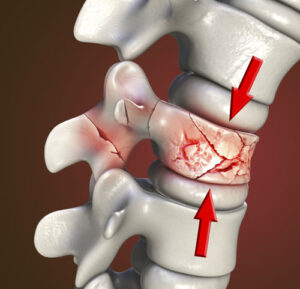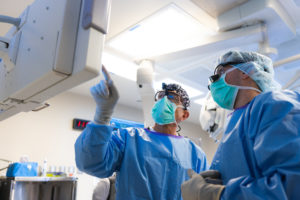Spinal Fracture
Spinal fractures can involve the vertebral body or the posterior elements of the spine. The posterior elements from the back wall of the spinal canal and provide protection for the spinal cord.
Spinal fractures typically happen from something as dramatic as a fall, motor vehicle accident, or, in a patient with osteoporosis, from a simple movement like coughing or reaching overhead.
Many people mistake these spinal fractures for backaches, which they assume are just part of getting older. The primary symptom seen in compression fractures is moderate to severe back pain that is made worse by movement. When the spinal cord is involved, numbness, tingling, weakness, bowel/bladder dysfunction or even paralysis may occur.
Symptoms
 With a violent accident or fall, there can be acute and intense pain. Often there is pain with movement. If the injury was from a ground-level fall, it is still possible to have a spinal fracture if the bone is weakened due to medical illness or osteoporosis. If you are experiencing this, seek medical attention before you attempt to transport or mobilize yourself.
With a violent accident or fall, there can be acute and intense pain. Often there is pain with movement. If the injury was from a ground-level fall, it is still possible to have a spinal fracture if the bone is weakened due to medical illness or osteoporosis. If you are experiencing this, seek medical attention before you attempt to transport or mobilize yourself.
Spinal fractures often refer to trauma to the bone or ligaments from the base of the skull to the tailbone or coccyx. In low-energy trauma, often the fracture of a vertebral body results in compression without significant neurologic injury and without injury to the spinal cord or nerves. Sometimes, since the pain is mild, it is possible to mistake a fracture for a back sprain.
It is important to evaluate if a fracture is suspected to ensure proper spinal alignment is maintained and the nature of the fracture does not pose a risk to the spinal cord or neural structures. If you are experiencing any of these symptoms, seek medical attention before you attempt to transport or mobilize yourself.
Diagnosing
The first step in the evaluation of spinal fractures is to get a detailed history of what caused the injury. The doctor will perform a physical examination. This may include checking for swelling, bruising, tenderness, and other signs of injury to the head, abdomen, and back as well as evaluating strength, motion, and alignment of arms and legs.
A neurologic examination may also be done. This may include tests of sensory (temperature, pain, and pressure sensitivity), motor (muscle strength), and reflex functions of the nervous system. In addition, X-rays may be necessary to look for fractures or dislocations. Often computed tomography (CT) or magnetic resonance imaging (MRI) scans may be ordered to determine the extent of the injury.
Treatments
 Compression fractures due to osteoporosis can often be managed medically or without bracing depending on the severity of the injury. In cases of severe and intractable pain, cement with or without inflation of a balloon to restore height is used.
Compression fractures due to osteoporosis can often be managed medically or without bracing depending on the severity of the injury. In cases of severe and intractable pain, cement with or without inflation of a balloon to restore height is used.
In the trauma centers, spinal fractures from high-velocity injuries are managed based on an evaluation of the stability of the spine and the neural elements that are at risk. Often braces are used to help support the spine until there is healing of the fracture.
If there is significant compression or instability, the goals of surgical treatment are to provide early stability to maintain good early mobility. If there is bone within the spinal canal, it is removed directly or indirectly.

